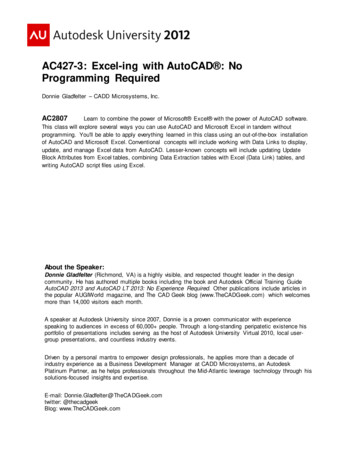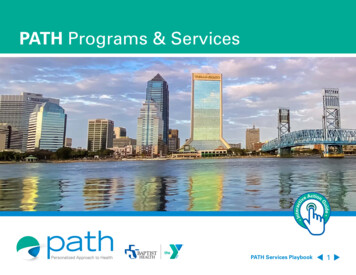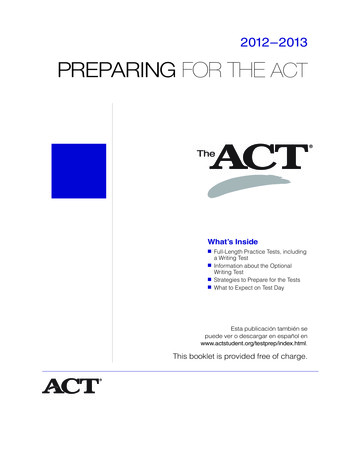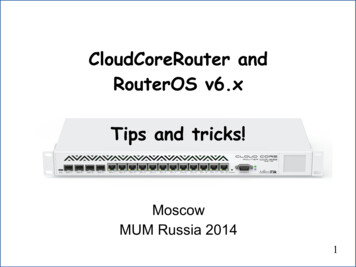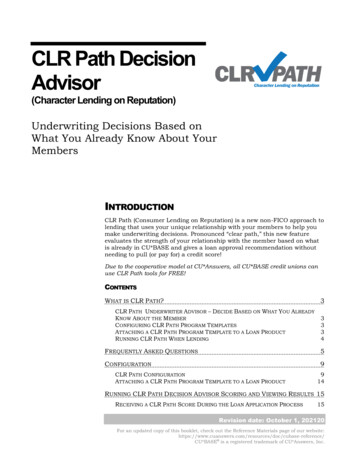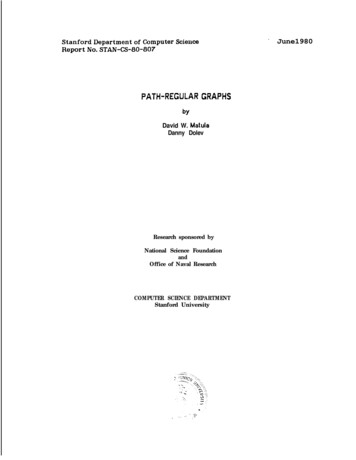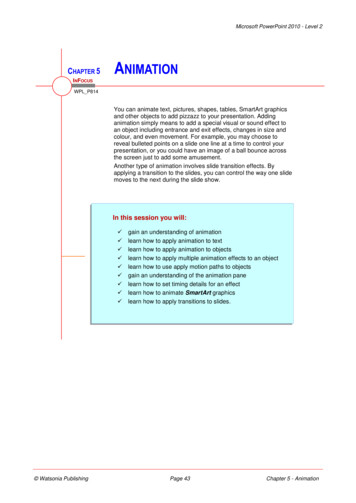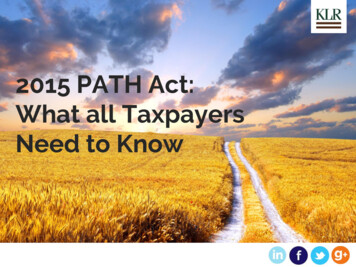
Transcription
2015 PATH Act:What all TaxpayersNeed to Know
AUTHORSLoree Dubois, CPALaura H. Yalanis, CPA,MSTLoree is the Chair of the Firm’sCorporate Tax Group and Co-Chair ofthe Firms Healthcare Services Group.She has over 20 years of experienceproviding tax advisory services toclosely held, medium sized andpublicly held businesses.Laura is the Chair of the Firm’sBusiness & Individual Tax Group andChair of the Firms Hospitality ServicesGroup. She provides tax advisoryservices to closely held and mediumsized businesses, and has extensiveknowledge of hospitality relatedindustries.
CONTENTS4 Introduction5 Overview: Good News for Taxpayers6 Part 1: Business Breaks: Section 179 Expensing9 Part 2: Business Breaks: Bonus Depreciation12 Part 3: Business Breaks: Accelerated Depreciation14 Part 4: Business Breaks: R&D Credit18 Part 5: Individual Breaks: Direct IRA Distributions to Charity20 Part 6: Individual Breaks: State and Local Sales Tax Deduction22 Part 7: Individual Breaks: Small Business Stock Gains Exclusion24 Part 8: Individual Breaks: Child-and Education Related Breaks28 Part 9: Individual Breaks: Mortgage-Related Breaks
INTRODUCTIONThis e-book will cover the mostsignificant tax law changes underthe Protecting Americans fromTax Hikes Act of 2015 (the PATHAct).4If, after reading this eBook, youwould like more information orhave questions about these tax lawchanges, please visitKahnLitwin.com or contact us attrustedadvisors@kahnlitwin.com.Share:
OVERVIEWGood News for TaxpayersThe PATH Act was signed into law onDecember 18, 2015. Without it, many valuabletax breaks for businesses and individualswould not have been available for 2015 and2016.That said, with tax reform continuing to be apopular topic in Washington and 2016 beingan election year, taxpayers still need to beprepared for future tax law changes.“Permanent” doesn’t mean a break will beavailable forever; it just means that itdoesn’t have a set expiration date.Congress could repeal or change some ofthese breaks in the future.But the act doesn’t just extend breaksthrough 2016 — it makes many breakspermanent. This is good news for taxpayersbecause it provides both long-term, taxsaving opportunities and more certaintyabout the breaks that will be available in the In the meantime, it’s important to factor thechanges into your 2015 tax return filing andfuture, which helps make planning easier.your tax planning for 2016 and beyond.45Share:
Part 1.Business Breaks: Section 179 ExpensingThe PATH Act makes permanent higherlimits under Sec. 179 of the InternalRevenue Code. This section allowsbusinesses to immediately expense thecost of qualified property (generallydepreciable tangible personal property,whether new or used) in the year it’s placedin service. So businesses can acceleratetheir tax deductions compared torecovering the costs over several yearsunder the applicable depreciation schedule.(Be aware that this deduction can be takenonly against net income. You can’t use it tocreate or increase a net operating loss.)46The PATH Act allows a business to deductup to 500,000 in qualified new or usedproperty for 2015. However, a dollar-fordollar phase-out applies to the extent thatthe cost of all qualified property placed inservice during the tax year exceeds 2.01million and is completely eliminated whenthe cost is above 2.51 million.Additionally, the Sec. 179 cap will beindexed to inflation in 10,000 incrementsin future years.Share:
PART1.ExpensingOVERVIEWSection 179Without the PATH Act, the expensing limits for 2015 and 2016 would have been only 25,000, with a 200,000 phaseout threshold.The new law also permanently allows off-the-shelf computer software to beconsidered qualified property. In addition, beginning in 2016, air conditioning andheating equipment will be considered qualified property. Previously, they werespecifically excluded from such treatment.Finally, the PATH Act makes permanent the ability to apply Sec. 179 expensing toqualified leasehold-improvement, restaurant and retail-improvement property. Theexpensing limit for such property is 250,000 of the full 500,000 expensing limit for2015 but the entire Sec. 179 expensing limit can be applied to such property beginningin 2016.7Share:
PART1. OVERVIEWPlanning Tips:128When filing your 2015 tax return, determine whether you purchased —and placed in service — property that qualifies for Sec. 179 expensingand the amount of the potential deduction. Then assess whether thisbreak will be beneficial to you long-term. If your business is growing andyou expect to be in a higher tax bracket in future years, opting out of theelection and depreciating the property over the applicable depreciablelife might ultimately provide greater tax savings.In 2016, carefully consider Sec. 179 when planning purchases for theyear. If you can qualify for this break and it will be beneficial to you,consider purchasing (and placing in service) just enough qualifyingproperty during the year that you can enjoy the maximum benefit. That is,don’t allow your asset purchases to exceed the phaseout threshold.Share:
Part 2.Business Breaks: Bonus DepreciationThe PATH Act extends 50% bonusdepreciation through 2017. It then reduces itto 40% for 2018 and 30% for 2019. Underbonus depreciation, businesses can take anadditional depreciation deduction in theyear that qualified property is placed inservice.For 2015, qualified property includes newtangible property with a recovery period of20 years or less, off-the-shelf computersoftware, water utility property and qualifiedleasehold-improvement property.49Beginning in 2016, the PATH Act allowsbonus depreciation for qualifiedimprovement property regardless ofwhether the property is leased.The PATH Act also allows corporations toaccelerate the use of alternative minimumtax (AMT) credits in lieu of bonusdepreciation under special rules. Beginningin 2016, it increases the amount of AMTcredits that can be used in lieu of bonusdepreciation.Share:
PART1. OVERVIEWPlanning Tips:1When filing your 2015 return, assess whether Sec. 179 expensing or 50%bonus depreciation will provide you the greater benefit:If your property acquisition expenses are eligible for both breaks,Sec. 179 expensing will provide a greater current-year tax benefitbecause it allows you to deduct 100% of the expense.If your property acquisitions for the year are greater than the Sec.179 phaseout threshold or your acquisition expenses exceed your2015 income, bonus depreciation may provide a larger tax benefit.10Share:
PART1. OVERVIEWPlanning Tips:2311If typically your annual qualified property acquisitions exceed the Sec.179 phaseout threshold, you may want to accelerate purchases into2016 and 2017 so you can take maximum advantage of 50% bonusdepreciation before the bonus percentage drops to 40% in 2018.As with Sec. 179 expensing, if your business is growing and you expectto be in a higher tax bracket in future years, forgoing bonus depreciationand depreciating the property over the applicable depreciable lifemight ultimately provide greater tax savings.Share:
Part 3.Business Breaks: Accelerated DepreciationThe PATH Act makes permanent the abilityto apply a shortened recovery period of 15years (rather than 39 years) to qualifiedleasehold-improvement, restaurant andretail-improvement property.“Permanent” doesn’tmean a break will beavailable forever; it justmeans that it doesn’thave a set expirationdate.412Share:
PART1. OVERVIEWPlanning Tip:1For property that qualifies for Sec. 179 expensing, bonus depreciationand accelerated depreciation, you can first apply Sec. 179 expensing upto the applicable limit, then apply 50% bonus depreciation to anyamount in excess of that limit, and then apply the 15-year recoveryperiod to the remaining amount.Example: If in 2015 you had a 400,000 qualifying leaseholdimprovement, you can first deduct 250,000 of the expense under Sec.179, then deduct 75,000 under bonus depreciation (50% of thedifference between 400,000 and 250,000), and then apply the 15-yearaccelerated depreciation to the remaining 75,000, providing anadditional 5,000 deduction in 2015. So your total 2015 deduction forthe property could be as much as 330,000.13Share:
Part 4.Business Breaks: R&D CreditThe research and development (R&D) creditrewards businesses that increase theirinvestments in research. The credit hasbeen around for decades, but it continuallywas allowed to expire and then would betemporarily extended. As a result of thisuncertainty, businesses couldn’t rely on thetax benefits of the credit when planning fortheir research investments. Thanks to thePATH Act, they now can. The PATH Actmakes the credit permanent.414The PATH Act also enhances the creditbeginning in 2016. For example, businesseswith 50 million or less in gross receipts canclaim the credit against alternativeminimum tax (AMT) liability. In addition,certain start-ups (in general, those with lessthan 5 million in gross receipts) thathaven’t yet incurred any income tax liabilitycan use the credit against their payroll tax.These two provisions mean that a lot morebusinesses will be able to benefit from thecredit when they file their 2016 returns in2017.Share:
PART1. OVERVIEWR&D CreditTo be eligible for the credit, your business must have engaged in “qualified” researchactivities during the tax year. These are activities that meet the following four-factor test:1.The activities’ purpose must be to create new — or improve existing —functionality, performance, reliability or quality of a product, process, technique,invention, formula or computer software that will be sold or used in your tradeor business.2. The intention must be to eliminate uncertainty.3. There must be an experimentation process.4. The experimentation process must rely on principles of physical or biologicalscience, engineering or computer science.15Share:
PART1. OVERVIEWR&D CreditThe research must be performed within the United States or its territories andpossessions. Certain activities are specifically excluded from the credit, such as reverseengineering, software development for internal use and research related to socialsciences, arts or humanities. You also can’t claim a credit for research funded orreimbursed by a third party via a contract, grant or other arrangement.Expenses that qualify for the credit include wages for time spent supporting,supervising or performing qualified research, supplies used in the experimentationprocess, and 65% of any contracted outside research expenses.16Share:
PART1. OVERVIEWPlanning Tip:1There are three options for computing research credits: the traditionalmethod, the alternative simplified credit method and the start-upcalculation method. Regardless of the method, the calculation iscomplicated, requiring businesses to not only calculate the current year’squalified research expenses but also factor in certain financialinformation from previous years.So professional advice is essential — whether you’re determining if youqualify for the credit on your 2015 return or are deciding if you’ll increaseyour R&D spending in 2016.17Share:
Part 5.Individual Breaks: Direct IRA Distributions to CharityIn recent years, charitably inclinedtaxpayers over age 70½ have been eligiblefor an attractive tax break: the ability tomake direct distributions of up to 100,000annually from their IRAs to qualifiedcharities. However, this was a temporarybreak, which sometimes made takingadvantage of it a challenge. For example, inboth 2014 and 2015, the break had expiredat the end of the previous year and wasn’trevived for the current tax year until midDecember — leaving taxpayers little time toexecute their distributions by the end of thetax year.418Now the PATH Act has made this breakpermanent. For eligible taxpayers, theamount of the direct distributions to charityup to the annual limit is excluded fromtaxable income. In addition, the distributioncan help satisfy the taxpayer’s IRA requiredminimum distribution (RMD) for the year.But the taxpayer can’t take a charitablededuction for the contribution. Also beaware that donor-advised funds andsupporting organizations aren’t qualifiedcharities for the purposes of this break.Share:
PART1. OVERVIEWPlanning Tips:191You can benefit from the break on your 2015 tax return only if you hadyour IRA trustee make a direct transfer to an eligible charity byDecember 31, 2015.2If you’re charitably inclined, meet the age requirement and haveenough assets outside your traditional IRA so that you aren’t planning totake more than your RMDs during your life, direct IRA distributions tocharity — even beyond your RMDs (as long as they don’t exceed the 100,000 annual limit) — may be right for you. Why? If you name a childor other loved one as beneficiary of your traditional IRA, he or she willhave to pay income tax (at ordinary-income tax rates, not the morefavorable long-term capital gains rates) on the distributions received.Share:
Part 6.Individual Breaks:State and Local Tax Sales DeductionFor taxpayers in most states, the federalitemized deduction for state and localincome taxes paid is a valuable tax break.But there are a handful of states that levyno income tax, or levy an income tax ononly a limited basis (such as only onunearned income).20A temporary break allowing an itemizeddeduction for state and local sales taxes,instead of state and local income taxes, hasbeen providing saving opportunities totaxpayers in these states for several years.But it was only temporary. The PATH Acthas made it permanent. The sales taxdeduction can also benefit taxpayers inother states who purchase major items,such as a car or boat.Share:
PART1. OVERVIEWPlanning Tips:211Don’t worry if you don’t have receipts documenting all of the sales taxyou paid in 2015. You can still claim the break on your 2015 return. Allyou need to do is use the IRS sales tax calculator. It determines thededuction based on your income and the sales tax rates in your locale.To that amount you can add the tax you actually paid on certain majorpurchases, such as a car or boat, provided that you have propersubstantiation.2Even if you live in a state that levies an income tax, if you have a yearwhen your taxable income is low and you’ve made a major purchase, youmight save more tax from the sales tax deduction than from the incometax deduction. You could also consider timing strategies where you“bunch” major purchases into alternating years.Share:
Part 7.Individual Breaks: Small Business Stock GainsExclusionInvesting in qualified small business (QSB)stock offers taxpayers multiple benefits,such as portfolio diversification and, undercertain circumstances, tax-free gainrollovers.If such stock is held for more than fiveyears, a gain exclusion is available when thestock is sold. The amount of the exclusiondepends on when the stock was acquired.22The PATH Act makes permanent theexclusion of 100% of any gain on the sale ofQSB stock acquired after September 27,2010. Without the legislation, QSB stockacquired after December 31, 2014, wouldhave been eligible for only a 50% exclusion.Also permanently extended by the PATHAct is the rule that eliminates QSB stockgain as a preference item for alternativeminimum tax (AMT) purposes. In otherwords, such gain won’t be a potential AMTtrigger.Share:
PART1. OVERVIEWPlanning Tip:231If you’re considering investing in small-business stock because youwant to take advantage of the 100% gain exclusion, make sure the smallbusiness you’re considering is indeed qualified. It must be a domestic Ccorporation whose gross assets have never exceeded 50 million, and itmust use at least 80% of its assets in an active trade or business.2In addition, you must acquire the stock at its original issue in exchange formoney or property or as compensation for services. Keep in mind thatinvestment decisions shouldn’t be made based only on potential taxbenefits. You also should consider your risk tolerance and investmentgoals, among other factors.Share:
Part 8.Individual Breaks:Child-and Education-Related BreaksTaxpayers with children under age 17 at theend of the year may be eligible for a 1,000child credit per qualifying child. If the childcredit exceeds the taxpayer’s tax liability forthe year, the taxpayer may be eligible for a“refundable” credit equal to 15% of earnedincome in excess of the applicablethreshold.24The PATH Act makes permanent the 3,000 threshold, which had beenscheduled to increase to an inflationadjusted 10,000 after 2017. The 3,000threshold means that more taxpayers willbe eligible for a refundable credit, and thedollar amount will generally be larger.Share:
PARTOVERVIEWBreaksChild-and1.Education-RelatedA tax credit that can be valuable to parents of older children is the AmericanOpportunity credit. It can be up to 2,500 for tuition and certain other expenses foreach of the first four years of postsecondary education.The PATH Act makes the American Opportunity credit permanent. Without thelegislation, the break would have reverted to the less-favorable “Hope” version of thecredit after 2017. Under the Hope version, the credit would have been only 1,800 andavailable for only the first two years of postsecondary education.The PATH Act also addressed another education-related break: the above-the-linededuction for qualified tuition and related expenses for higher education. But ratherthan making the deduction permanent, the act only extends it through 2016. Themaximum deduction is 4,000 for taxpayers whose adjusted gross income (AGI) doesn’texceed 65,000 ( 130,000 for joint filers) and 2,000 for taxpayers whose AGI exceedsthose amounts but doesn’t exceed 80,000 ( 160,000 for joint filers).25Share:
PART1. OVERVIEWPlanning Tips:1226Because credits reduce tax dollar-for-dollar, it’s especially importantfrom a tax-saving standpoint to make sure you claim every credit forwhich you’re eligible.You can’t take both the American Opportunity credit and the tuitiondeduction for the same student. If you’re eligible for both breaks on your2015 tax return, the American Opportunity credit will likely providemore tax savings.Share:
PART1. OVERVIEWPlanning Tips:3227Be aware that income-based phaseouts apply to the child credit and theAmerican Opportunity credit. If such a phaseout prevents you fromclaiming the full American Opportunity credit, consider having your childclaim the credit. You’ll have to give up your personal exemption for thechild, but family-wide there may be greater tax savings. If your personalexemption is eliminated due to the AMT or an income-based phaseout,you’ll lose nothing by forgoing the exemption.Share:
Part 9.Individual Breaks: Mortgage-Related BreaksThe PATH Act extends two mortgagerelated breaks, but only through December31, 2016. The first break allows taxpayers todeduct qualified mortgage insurancepremiums as if they were mortgage interest28The second break temporarily extended bythe PATH Act is the exclusion from grossincome for mortgage loan forgiveness on aprincipal residence. Under the act, theexclusion can also apply to mortgageforgiveness in 2017 as long as it’s grantedpursuant to a written agreement enteredinto in 2016. The maximum exclusion isgenerally 2 million.Share:
PART1. OVERVIEWPlanning Tips:291The deduction for qualified mortgage insurance premiums phases outfor taxpayers with AGI of 100,000 to 110,000. Generally it’s best, ifpossible, to make additional principal payments as quickly as you canafford to in order to get your home equity to the level that your lender nolonger requires you to maintain mortgage insurance. Even if you’reeligible for the deduction, you’ll save more by not having to pay thepremiums at all.2If you are considering a mortgage workout that could include debtforgiveness, consider trying to enter into a written agreement in 2016 soyou can take advantage of the forgiveness exclusion. Otherwise, youcould end up owing substantial tax on what is considered “cancellation ofdebt” income. However, keep in mind that, if you keep the home, youmust reduce your basis in the home by the amount of the excludedforgiveness — which could result in a larger tax bill when you sell thehome.Share:
SHARE THIS eBOOKShare this eBook!Visit our tax blog learn more about the 2015 Tax Extenders.Find out why KLR is so much more than an accounting firm.KLR is one of New England’s premier accounting andbusiness advisory firms. With 200 team members andoffices in Boston, Newport, Providence, Shanghai andWaltham, KLR provides a wide range of services to bothindividuals and businesses.KahnLitwin.com
The PATH Act was signed into law on December 18, 2015. Without it, many valuable tax breaks for businesses and individuals would not have been available for 2015 and 2016. " But the act doesn't just extend breaks through 2016 — doesn't have a set expiration it makes many breaks permanent. This is good news for taxpayers

